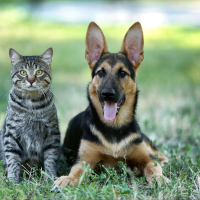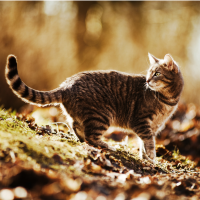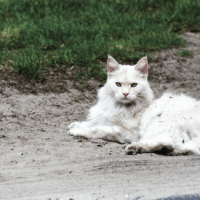When I am petting my cat, why does she turn around and bite me?
This type of behavior in cats is usually quite confusing to owners. Initially, the cat acts like it enjoys the physical contact and may even purr and rub against the person. However, after a variable period of time, the cat may become agitated and turn and bite the hand that is petting it. Usually these bites are inhibited, but they can be injurious and severe in some cases.
This has often been called the “go away” bite. What appears to be happening is that for a period of time the cat enjoys the interaction, but at some point the physical sensation of being stroked and scratched is no longer pleasant. The cat then endeavors to change the situation by an aggressive outburst.
Is there any way for me to predict when this is going to happen?
For some cats, it is important to realize that interaction with the owner may not always be a solicitation for petting. Sitting nearby or on the lap may not mean that the cat desires petting. Subtle signs of a change in motivation are usually present, but owners often miss these signs that the cat no longer wants physical contact.
The cat may show very slight changes in body posture including tail twitching, body tensing, dilated pupils, or ear movements such as flattening the ears against the head, or more obvious signs such as growling or hissing. In some cases, if you stop all physical interactions, the cat will become calmer and will not bite. In other situations, the cat may bite and then move away or leave the situation.
The behavior is often directed toward familiar people, but can also be displayed toward unfamiliar people. Fear is the most likely cause if the cat does not allow any petting or interaction by strangers.
Are there other reasons my cat might bite me when I attempt to pet her?
Anxiety, pain, or skin conditions may all be contributory in a cat that resists physical contact. Dental disease or other metabolic conditions or illness may increase irritability and lower the cat’s threshold for aggressive responses and tolerance to handling. If the behavior is new, a veterinary examination for medical causes is warranted. For some cats, it is important to realize that interaction with the owner may not always be a solicitation for petting. If the cat was not handled as a young kitten, or was poorly socialized, it may not be familiar with nor desire physical contact with people.
Once this behavior begins, owners will respond to the cat’s bites in one of a number of ways. If you respond by no longer petting the cat, you will reinforce the cat for biting. If you punish your cat or become increasingly upset or anxious, you may add to the problem, since the cat may allow petting in the future but also be anxious and nervous at the same time. This is known as conflict behavior (competing motivations).
How can I treat this condition?
The first step is to become aware of the warning signals that the cat gives as it is becoming agitated (e.g., twitching tail, ears back, dilated pupils). At the very first sign of these signals, all petting and physical contact must cease. In some cases, this will prevent the aggression from escalating and may be enough to control the problem.
In other situations, it may be possible to teach the cat to tolerate increased physical contact without an aggressive response. This entails identifying the threshold for the aggressive response (i.e., “how many” or “for how long” the petting is tolerated before the cat begins to become agitated). The goal is to stop petting the cat before that threshold is reached, and to reward the cat with a tasty food tidbit for tolerance of petting. If the cat shows aggression, the petting session must be stopped. Over time it may be possible to increase the number of “pats” before the cat no longer tolerates the interactions.
In some circumstances, it is more realistic to understand and embrace the type of interaction that the cat desires. For some cats, this means that the cat sits close by or even on your lap without physical contact. Other cats may tolerate light scratching around the neck and chin rather than long strokes down the back and sides.
Petting interactions can be supplemented or replaced with other types of interactions that are mutually satisfying to the owner and the cat. These might include playtime with toys, teaching tricks, or playing games.
At no time should you yell at the cat or use physical punishment. These actions will tend to increase anxiety, fear, and arousal rather than teach the cat not to be agitated. If the cat begins to show anxiety or aggression, calmly but quietly leave the area even if it means slowly standing up and allowing the cat to jump off your lap.
For some cats the use of pheromone diffusers (Feliway®) are quite calming and may be a useful adjunct to treatment. Keeping the cat’s nails trimmed may also diminish injury. If the problem is severe, the cat may need to be confined away from small children and people with physical disabilities or immunocompromised status.
© Copyright 2013 LifeLearn Inc. Used and/or modified with permission under license.






